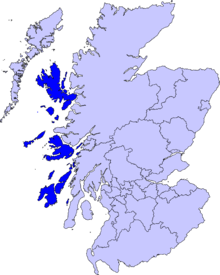Birlinn
In 1310, King Robert the Bruce granted Thomas Randolph, 1st Earl of Moray a reddendo or charter making him Lord of the Isle of Man in exchange for six birlinns of 26 oars.
In an island environment ships were essential for the warfare which was endemic in the area, and local lords used the birlinn extensively from at least the thirteenth century.
His orders included the destruction of shipping, named in his commissions as lymphads, galleys, and birlinns belonging to rebellious subjects.
There is some evidence for mercantile centres in Islay, Gigha, Kintyre and Knapdale, and in the fourteenth century there was constant trade between the Isles, Ireland and England under the patronage of local lords.
It is possible that the resources of the Highlands and Islands were not sufficient to support both naval and trading types of ship, leaving the galley with both roles.
[13] The stem and stern post sometimes had carefully carved notches for plank ends, with knees securing the thwarts to the strakes and beams joining the heads of the frames.
[14] The hull bore a general resemblance to the Norse pattern, but stem and stern may have been more steeply pitched (though allowance must be paid for distortion in representation).
Nineteenth-century boat-building practices in the Highlands are likely to have applied also to the birlinn: examples are the use of dried moss, steeped in tar, for caulking, and the use of stocks in construction.
[20] Carved images of the birlinn from the sixteenth century and earlier show the typical rigging: braces, forestay and backstay, shrouds (fore and aft), halyard and a parrel (a movable loop used to secure a yard or gaff to a mast).
[22] Traditional Highland practice was to make sails of tough, thick-threaded wool, with ropes being made of moss-fir or heather.
[26] The Irish long fhada seems, from contemporary sources, to have resembled its West Highland equivalent, though there is as yet no archaeological confirmation.
[29] In Ireland oared vessels were employed extensively for warfare and piracy by the O'Malleys and the O'Flathertys, western lords whose base was in Connacht.
[30] The most famous of these local rulers was Grace O'Malley, of whom Sir Richard Bingham reported in 1591 that she had twenty vessels at her command.
An English map of north-east Ireland made no later than 1603 shows "fleetes of the Redshanks [Highlanders] of Cantyre" with vessels one-masted as before but with a square sail mounted on a sloping yard arm and a small cabin at the stern projecting backwards.
[36] Two Clanranald seals attached to documents dated 1572 show a birlinn with raised decks at stem and stern, a motif repeated in later heraldic devices.



